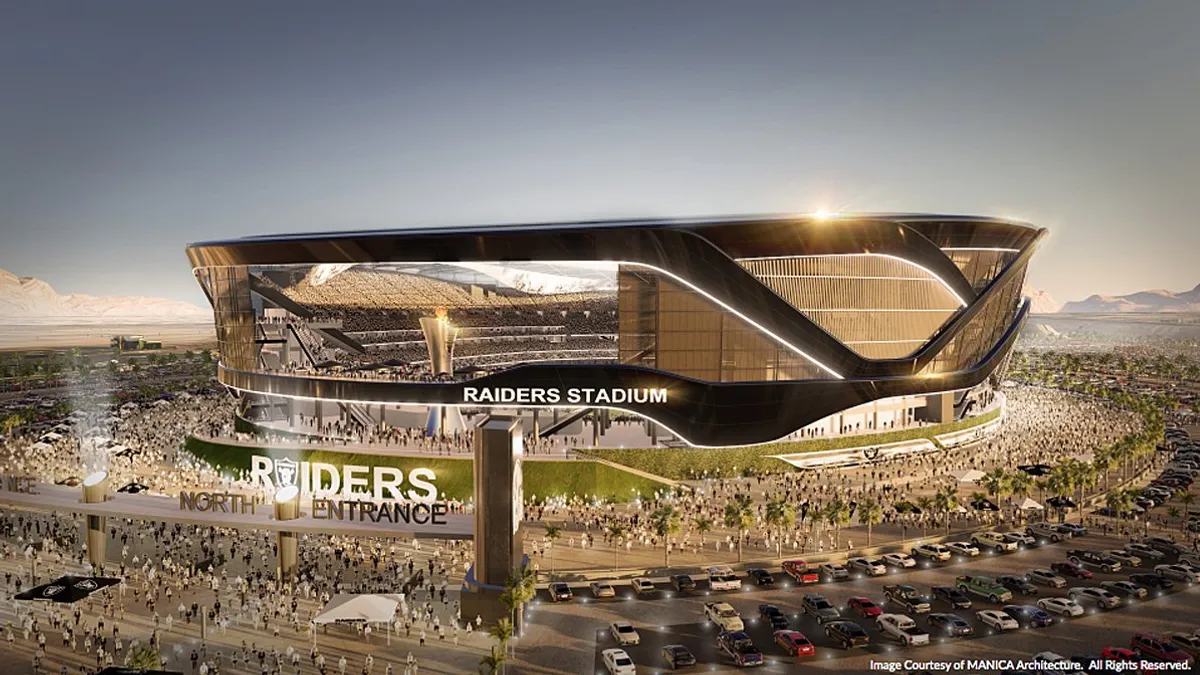UPDATE, Jan. 4, 2018 — The Las Vegas Raiders got the official OK from Clark County, NV, commissioners to move forward with their new 65,000-seat stadium, according to the Las Vegas Review-Journal. In exchange for the stadium, the Raiders have agreed to finance infrastructure improvements and public safety services around the development, including sidewalk expansions, and potentially constructing a footbridge over Interstate 15 that would connect the stadium to the Mandalay Bay resort and casino.
At this time, the team can only build out — not up. To begin vertical work on the more than 200-foot-tall stadium, the Raiders are charged with securing funding and developing a plan for deconstruction.
UPDATE, Nov. 14, 2017 — Officials broke ground on the much-anticipated Raiders stadium late Thursday evening, The Sacramento Bee reported. Slated to open in time for the 2020-21 NFL season, the 65,000-seat stadium will be built on the University of Nevada, Las Vegas' campus and will be shared between the Raiders and the university.
UPDATE, Nov. 10, 2017 — The Raiders and Las Vegas Stadium board could be required to pay millions more annually for their new stadium if the GOP tax plan is approved, SF Gate reported. The added $3 million-per-year cost would not undo plans for the stadium, according to Clark County officials, but Nevada congressional representatives are reportedly seeking an exemption for the project.
The board was not allowed to vote on the plan Thursday because it had been earmarked as a discussion item on the agenda, the Las Vegas Sun reported, but it could see final approval when the board convenes next month.
Dive Brief:
- The Las Vegas Stadium Authority on Thursday is scheduled to hammer out more details and possibly finalize agreements around the construction of the Raiders' new $1.9B stadium, according to the Las Vegas Review-Journal.
- Items that the LVSA is set to review: a list of acceptable construction activities that crews are able to perform while a final development agreement is being negotiated and the hiring of a property management company to oversee that work; how small business, local workers and philanthropic goals could be served by a community benefits plan; when the team will hold an official groundbreaking; and the potential fallout from a House GOP tax bill that would eliminate the tax-exempt benefit of stadium bonds, a funding tool the LVSA was planning to use to help pay for its $750 million share of stadium costs.
- Some of these items were supposed to be addressed last month, but Authority Board Chairman Steve Hill canceled the October meeting on the grounds that the members needed more time to work on pending agreements.
Dive Insight:
The issuance of tax-exempt stadium bonds is the way many local governments help to finance new stadium and sports-venue construction or upgrades, and a team's willingness to stay in a city sometimes hinges on their ability to do so.
After House Republicans introduced their tax reform bill, the National Football League (NFL) came out publicly in opposition, Reuters reported. The league's position is that stadiums provide an economic benefit for the communities in which they're built, so the projects should be able to receive some tax breaks. Former President Barack Obama also suggested eliminating this vehicle as a way to fund stadium development back in 2015.
Since 2000, state and local governments, according to Axios, have used $13 billion of tax-exempt stadium bonds to help fund the construction of sports venues, a practice that a 2016 Brookings Institution study said resulted in a $3.2 billion loss in tax revenue for the federal government from 2000 to 2014. AT&T Stadium in Dallas, Little Caesars Arena in Detroit, US Bank Stadium in Minnesota and Citi Field in New York are just some of the venues that have benefited from tax-exempt bonds.












